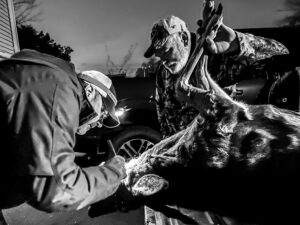ORLEANS — In the long, flat twilight of a December afternoon, two pickup trucks rolled up to the rear entrance of the Goose Hummock Shop in Orleans a few minutes apart. Each carried a deer: a doe in one, a buck in the other. It was Saturday, the last day of the first week of shotgun season, and these would be Stephen Wright’s final check-ins of the year.

Wright, a wildlife biologist with the Mass. Div. of Fisheries and Wildlife, hopped out of his own truck to greet the hunters. For 15 years, this has been his post during the week after Thanksgiving.
During other weeks of the deer season, hunters can register their kills online. But the need for data on the deer population means that this week Wright and dozens of other biologists at check-in stations around the state become part of a tradition: paper tags, face-to-face conversations, and a physical examination of flesh and bone.
From 9 a.m. to 5:30 p.m. each day, Wright logs the weight and age of each deer and where it was harvested. He swabs some of them for diseases, including Covid, which has been detected in about 20 percent of tested deer in the state, though they show no symptoms.
“Hunting is our management tool to control deer numbers,” Wright told the Independent. Wright is also a hunter, although he prefers bow season, which ended the Saturday before shotgun season began.
The ideal density for deer, he said, is about 15 to 18 per square mile. “At higher levels, you’ll have a degradation of habitat and more frequent negative interactions with people, like vehicle collisions and property damage,” he said.
A hunting license includes two tags — known as “buck tags” — for deer with antlers at least three inches long. Regardless of method — bow, shotgun, or even muzzle-loading “primitive firearms” — hunters can harvest no more than two antlered deer per year in the state. Special permits are required to hunt antlerless deer, including does and button bucks.

Wright lives in Eastham, so his commute to Goose Hummock is short. But the entire week is a waiting game, with his truck doubling as an office. He makes phone calls and does his Christmas shopping online.
“This is traditionally one of the slowest check stations in the state,” he said. “It typically tapers after the first day.”
The doe and buck brought in on Saturday were numbers 26 and 27 for the week. Last year, Wright checked 19 deer here — close to the past decade’s average. The lowest count here was 11 deer in 2019 and 2021, while the high was 31 in 2022.
The Mobil gas station in Wellfleet, the only check station on the Outer Cape, is even slower. Mike Slaibi, who owns the gas station, said that by last Friday only one deer — a 150-pound buck with four-inch antlers — had been checked there.
“Nobody knows that we tag them,” said Slaibi. “The only reason I do the tag is that the hunters buy beer when they come.”
Check-In Rituals
Under the glow of a headlamp, Wright examined the teeth of the doe brought in by hunter Eben Higgins of Brewster, who had been hunting near Nauset Light in the National Seashore with his father, James.

The doe still had some baby teeth, and her second and third premolars hadn’t fully emerged, so Wright estimated she was about one-and-a-half years old.
“I knew she wasn’t a skipper,” said James, using the term for a fawn still tethered to its mother.
James now lives in Sydney, Maine, but he has hunted here for over 50 years, learning from his own father, who is 80 and sat out this hunt to play Santa Claus.
The Higginses helped Wright hook the doe’s hind legs to the scale and hoist her up. Field-dressed, she weighed about 80 pounds. With Eben’s permission, Wright removed her lymph nodes to test them for chronic wasting disease, which causes fatal nerve damage to white-tailed deer, mule deer, moose, and elk.
Chronic wasting disease has not yet been detected in Massachusetts, but Wright takes random samples as a precaution. He used a knife to extract several lymph nodes lining the esophagus.
“Taking a cavity?” joked Daryl Chase of Eastham as he pulled into the station with a buck he shot in Wellfleet. He opened the latch on his truck bed and said that he, too, hunted on Seashore land.
“It’s all the same woods,” said Chase. “It’s nothing for the deer to go from Eastham to Wellfleet in minutes.”
The four men hooked Chase’s buck onto the scale; it weighed in at 100 pounds. With a practiced hand, Wright sawed open its jaw to examine its teeth. The buck was older than the doe, around two-and-a-half years old.
Twenty-seven deer was a fairly typical number at Goose Hummock, Wright said, but he had noticed the absence of some older hunters he usually saw each year.
By the time Wright was finished with Chase’s buck, the light had faded entirely. He turned off his headlamp, marking the end of his annual week-long vigil. Then he joined the others in conversation, three hunters becoming four in the dark, swapping plans for their venison: summer sausage, jerky, steaks to last through the winter.
Shotgun season ends on Dec. 14, and primitive firearms season begins on Dec. 16. For hunters, the rhythm of the season rolls on, one tag at a time.
